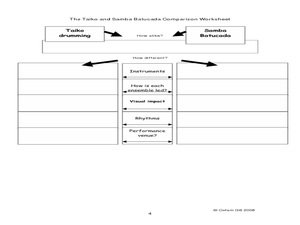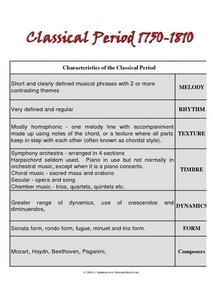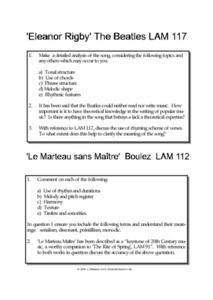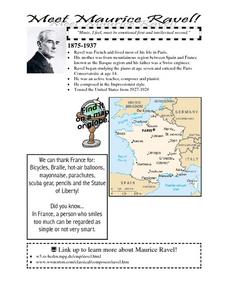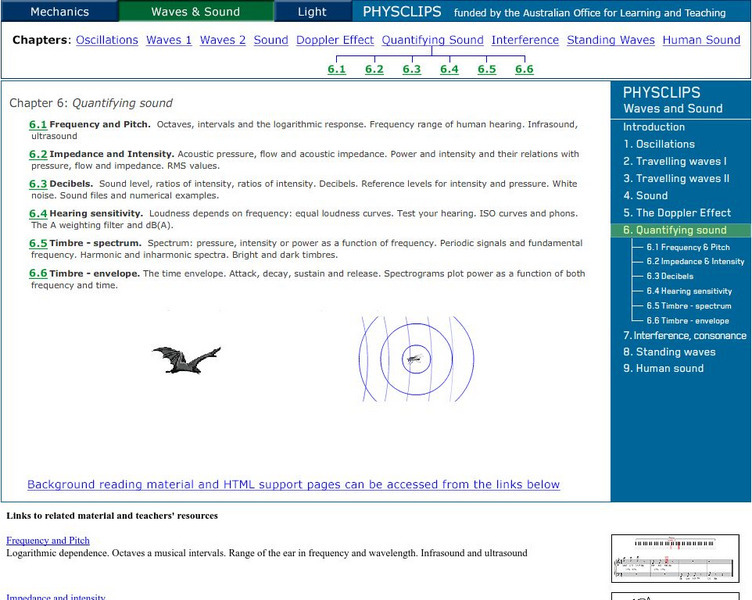Curated OER
Musical Instrument Families
Using graphics, and an easy-to-understand format, this resource outlines the different kinds of instruments and their characteristics. This presentation could be used as an introduction to instruments for young scholars getting ready to...
California Department of Education
Waves and Music
Strike the right chord with a musical activity! Instructors provide a lecture on the mechanics of a pan flute. Pupils build their own pan flutes by using straws and calculating the lengths to create a scale. After cutting the straws to...
Canada's National Arts Center
Vivaldi and The Four Seasons
Did you know that Vivaldi’s orchestra was largely made up of girls from an orphanage? Fun facts like this fill a 34-page teacher's kit designed to accompany a cross-curricular study of Vivaldi's The Four Seasons.
Leading Learner
Using Music to Tell a Story or Describe a Scene
Young composers demonstrate their understanding of the stylistic features of descriptive music, including pitch, tempo, dynamics, rhythm, and timbre, by developing a melody and countermelody for a main character in a story. As part of...
Classics for Kids
"Mars" from The Planets
Gustav Holst's The Planets provide young musicians an opportunity to examine how composers can create a suite: a collection of smaller pieces grouped to explore a single topic. After listening to "Jupiter," they examine "Mars" in...
Curated OER
Tone Poem Composing Project
Young scholars explore role of music in storytelling by watching and discussing effect music has on perception of scene from movie, and using Sibelius program to compose single excerpt of music, considering dynamics, timbre, and...
Curated OER
the Baroque Period
Baroque styles in music, together with trends in tone, melody, and form are summarized in these slides. The points given are short and relevant. There is only a small amount of information, so this would be best as an accompaniment...
Curated OER
Timbre: Identifying the Tone Color of the Saxophone
Students explore the concept of timbre. In this timbre instructional activity, students experience timbres produced by saxophones in contemporary music. Students explore the science behind the music.
Curated OER
Polyrhythmic Drumming Styles: Japan and Brazil
Young scholars explore cyclic patterns in drumming style. In this multicultural music lesson, students listen to and compare Taiko and Samba drumming styles and complete a compare/contrast worksheet.
Curated OER
Classical Period Music - 1750-1810
In this classical music worksheet, students examine a graphic organizer that explains 7 characteristics of the music. They examine characteristics such as melody, timbre, texture, dynamics, and melody. There are no questions associated...
Curated OER
Analyzing Songs- Eleanor Rigby by the Beatles, and Le Marteau san Maitre by Boulez
In this song analysis worksheet, student examine the tonal structures, chords, melodies, and rhythm structures of two pieces of music. They examine "Eleanor Rigby" by the Beatles, and "Le Marteau san Maitre" by Boulez.
Curated OER
Music in Other Cultures
Learners examine the musical concepts of timbre, melody, and rhythm. They listen to and identify characteristics of music from other cultures.
Curated OER
Changes of Musical Elements in Popular Music Through the Decades
Students probe samples of European classical, American jazz, and rock and roll to analyze the similarities and differences. The styles and form of these three types of music are examined for tempo, timbre, and rhythm.
Curated OER
Investigation of Timbre
Young scholars design an experiment to analyze the timbre of different instruments. In this physics lesson, students analyze the missing quality in sound. They discuss their results in class.
Curated OER
Timbre II
In this music worksheet, students learn that timbre, or tone color, means different kinds of sounds. Students complete 10 questions about timbre and general music topics.
Curated OER
Characteristics of the Classical Period
In this music instructional activity, students identify the specific characteristics of the Classical Period in music. They define seven key terms related to the period and who the composers were of that time period.
Curated OER
Pavane pour une Infante Defunte
Students describe the music in terms related to basic elements such as melody, rhythm, harmony, dynamics, timbre, form, style, etc. They identify timbres heard in "Pavane" by movement and respond by movement to timbre.
University of New South Wales (Australia)
University of New South Wales: School of Physics: Physclips: Quantifying Sound
Learn about terms to quantify sound like pitch, frequency, decibels, and much more in this learning module. Learning module includes animations and videos.
Other
The Brass Crest Cornet
Ignore the ads and find excellent info on the cornet. Provides a physical description, tone, its role in the brass band, cornet vs. trumpet, and the soprano cornet.
Texas Education Agency
Texas Gateway: Physics of Hearing: Hearing
By the end of this section, you will be able to define hearing, pitch, loudness, timbre, note, tone, phon, ultrasound, and infrasound; compare loudness to frequency and intensity of a sound; and identify structures of the inner ear and...
Annenberg Foundation
Annenberg Learner: Exploring the World of Music
This 12-video series examines elements of music such as melody, harmony, rhythm, and texture, and how they are used in a wide variety of music genres in cultures around the world.
SingWise
Sing Wise: Understanding Vocal Range, Vocal Registers, and Voice Type
Clear explanations of many terms used in evaluating and describing singing voices. Learning these explanations should help students find their comfortable singing ranges.
Georgia State University
Georgia State University: Hyper Physics: Sound and Hearing
Home page for a hypertext course on physics. Accesses a range of topics from hearing to sound measurement to sound propoation to musical instruments.
San Diego State University
Sd State: Elements of Music Part Five
This is an extensive website on other musical elements; but "accents" is thoroughly covered. You must scroll down to "dynamics."










